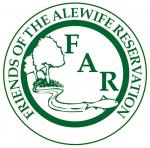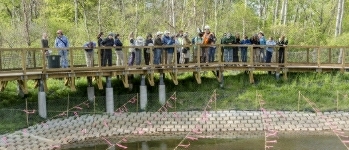Friends of Alewife Reservation, Silver Maple Forest Alliance, Green Cambridge protest the cutting
FAR and Alliance Call for Climate Change Conservation for preserving the floodplain land and remaining forest
By Sara Feijo | sfeijo@wickedlocal.com | Posted Oct. 29, 2014 @ 9:05 am
CAMBRIDGE
Developers have begun cutting down trees in a forest that borders Cambridge, Belmont and Arlington, but environmentalists say it’s not too late to save the wooded area.
They are calling on Cambridge officials to take action and ask the state to change the law for the Cambridge portion — 2.6 acres of the 15.6-acre forest, most of which is located in Belmont.
“We can take the land that belongs to Cambridge and we can let Belmont decide if they want to take their portion or not,” Quinton Zondervan, president of Green Cambridge, said Tuesday at a Cambridge Environmental and Health Committee hearing. “Second thing to do, change the law. The laws are wrong. The laws as they are currently in our state are not protecting our environment. They’re not protecting us. We need to fix that.”
The ongoing battle over the Silver Maple Forest started in 1998 when O’Neill Properties, a Pennsylvania-based real estate development company, announced it planned to build a commercial development over the forest, which is an integral part of the Alewife Reservation ecosystem.
The scope of the project changed after area residents raised objections. O’Neill Properties is in the process of acquiring the building permit from the town of Belmont to construct 298 units in the forest.
The proposed project, however, does not adequately meet the needs for stormwater management in the 100-year storm scenario, according to Bruce Jacobs, owner of HydroAnalysis, Inc., a small environmental consulting firm in Acton. The state’s Department of Environmental Protection uses stormwater guidelines from 1961 to calculate 100-year storm scenarios, and much has changed since they were drafted, Jacobs said.
“What we think of the 100-year-flood is likely not the 100-year-flood because it has changed over time,” said Jacobs, who reviewed drainage calculations for residents of Acorn Park Drive living adjacent to the forest, adding that an estimated 150,000 gallons of excess water are discharged in a 100-year storm scenario. Anne-Marie Lambert, a Belmont Town Meeting member and co-founder of the Belmont Stormwater Working Group, encouraged Cambridge city councilors to ask the town of Belmont what they plan to do with the unaccounted 150,000 gallons of water.
“Regulations are clearly not keeping up with the science and with the engineering, and it’s up to our politicians that we look to for leadership to change the laws and to make recommendations,” Lambert said. “Even with zero new development, we have an issue already with the rising ground water, the increased precipitation and the rising of the sea level.”
According to EkOngKar Singh Khalsa, executive director of the Mystic River Watershed Association, the impacts of the loss of open space on the watershed are vast. Khalsa said water quality in Alewife Brook has met standards less than 40 percent of the time for the past five years. The problem, he said, is that communities in the Alewife Brook and the Silver Maple Forest areas can’t get their sewage out to the treatment plant at Deer Island due to stormwater problems. “The area around Alewife Brook and Silver Maple Forest has been virtually paved, which means that there’s no way for rain water to sink into the ground,” Khalsa said. “It all goes into the stormwater system, which then blows up into the sewer system, which causes problems everywhere, and particularly downstream. So open space is what is missing from this picture.”
According to Khalsa, an estimated 60 million gallons of stormwater mixed with rain water were discharged into the Mystic River during the March 2010 storms. “These waters are already severely impaired by bacterial contamination,” he said.
Amy Mertl, an assistant biology professor at Lesley University, said the forest produces valuable economic benefits when it comes to ecosystem services. The forest, she said, could provide a minimum savings of $13.5 million over the next 20 years in air improvements, cooling costs, carbon sequestration and flood mitigation.
“This covers a whole range of benefits that forests provide for citizens near them, and this includes improvements to health; protection from disturbances, like flooding; there’s temperature regulation,” Mertl said.
According to Mertl, if the forest is cut down, Little Pond and the Alewife Reservation will suffer degradation and reduced biodiversity, and the area will see degradation of water, sediment and plant diversity in the stormwater wetland, along with increased invasive species.
The ABC Tri-Community Flooding Board of Arlington, Belmont and Cambridge will hold its second meeting on Tuesday, Nov. 11, at 6 p.m. at the Arlington Town Hall, 730 Mass. Ave.
Contact Chronicle reporter Sara Feijo at sfeijo@wickedlocal.com or follow her on Twitter at @s_fjo.
Article preserved 2014-11-02 from
http://cambridge.wickedlocal.com/article/20141029/NEWS/141026007
- Home
- Directions
- FAR Wildlife Blog
- Calendar
- News
- Donate Now
- Get Social!
- Storm Water Wetlands
- Plants and Restoration
- Photos
- Videos
- About & Projects
- Master Plan for Alewife
- Archive
- Newsletters
- Contact
 Presentation Spotlighting Alewife Reservation
Presentation Spotlighting Alewife Reservation
 Follow us on Twitter
Follow us on Twitter
 Like us on Facebook
Like us on Facebook
 Follow us on Instagram
Follow us on Instagram
Forward our web address to a friend!
- An Urban Gem - Alewife Reservation Nature Preserve
- Envisioning The Silver Maple Forest
- History and Policies of Cambridge, Belmont, and DEP
- Storm Water Wetlands
- Friends of Alewife Reservation brochure
(front, back) - Technical Analysis of Upper Alewife Basin
- Watershed: An Excursion in Four Parts
- The River Is A Restless Spirit: Life in the floodplain forest
-
Assessment of Silver Maple forest for DEP Adjudicatory hearings and
Patrick Fairbairn, author of the Assessment - Community Native Garden Flora
The
Alewife Reservation
is a unique natural resource for the communities of Belmont, Arlington and Cambridge
and home to hundreds of species, including hawks, coyotes beavers, snapping turtles, wild turkeys and muskrats,
the reservation is a unique natural resource for the community.
Historical information (Powerpoint)
Friends of Alewife Reservation works to protect and restore this wild area and the surrounding area for the water quality, native plants, animals and over 90 bird species with paths for walking, running and biking, recreation, and for classroom education and research. We regularly steward and preserve the Reservation area for wildlife and for the enjoyment of present and future generations.

(video)
By-Laws
About Friends of Alewife Reservation
Statement of Purpose
Citizen Forester newsletter archive
The Birds of the Cambridge Region of Massachusetts

by William Brewster 1906
Nuttal Ornithological Society
Biodiversity Study of Alewife Reservation Area: Species, Habitat, Ecosystems

Inventories by David Brown, wildlife assessor (2003, 2004.) Published by and available from FAR for $10. Write or call for your copy. (sample)
Updated Dave Brown Inventories (2008, 2010)
Inventories of Alewife Reservation Wetland Plants by Walter Kittredge, Botanist (2013)

